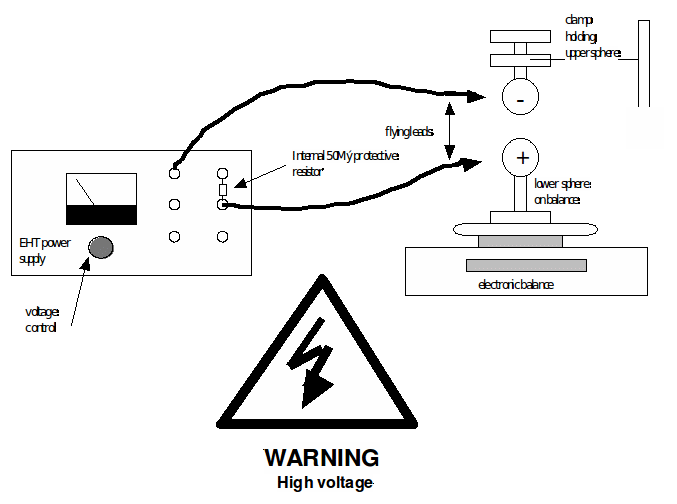Apparatus:
EHT power supply, electronic balance, two insulated metal spheres, clamp stand boss and clamp, two long wires.

Procedure:
1. Assemble the apparatus as shown above. Ensure that the positive flying lead is connected to the lower positive terminal (the one that protects YOU with a 50M¦ resistor). If you can, set the top-pan balance to read in newtons.
2. Tare the balance so that it reads zero.
3. Adjust the output of the EHT (Extra High Tension) supply so that its voltmeter reads 1000V.
4. Momentarily touch one flying lead to one sphere and the other lead to the other sphere. You should now notice a negative reading on the balance, (indicating an attractive force between the spheres).
5. Repeat stages 3 & 4 for 4 more values of voltage between 1000V and 3000V. In each case also calculate![]() Tabulate your results. (Ignore the negative sign of the force reading)
Tabulate your results. (Ignore the negative sign of the force reading)
6. Turn off the power supply.
7. Plot a graph of attractive force against voltage squared.
8. Measure the gradient of this graph.
9. According to Coulomb’s law, the force between two spherical charges is given by:![]()
Where:![]() &
&![]() are the two charges (equal and opposite in our case)
are the two charges (equal and opposite in our case)
![]() is the permittivity of the media between the charges
is the permittivity of the media between the charges
![]() is the distance between the centres of the spheres
is the distance between the centres of the spheres
It can also be shown that the potential (voltage) of a spherical charge is given by:
![]()
Where![]() is the charge on the sphere and r is the radius of the sphere.
is the charge on the sphere and r is the radius of the sphere.
Combine these two relationships to show that the force exerted between the two spherical charges is proportional to the square of their voltages.
(You may assume that![]() and
and![]() remain constant)
remain constant)
10. Explain how well your graph backs up the above statement.
